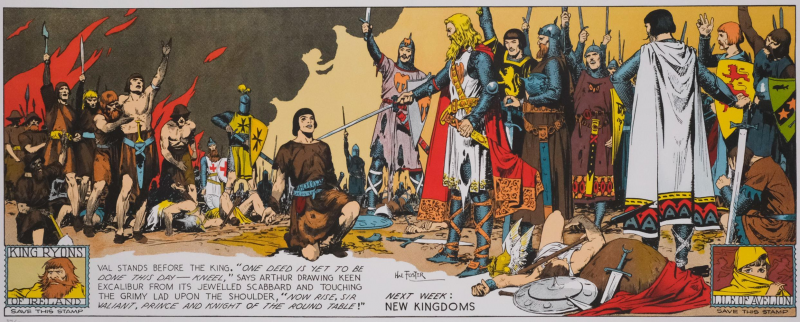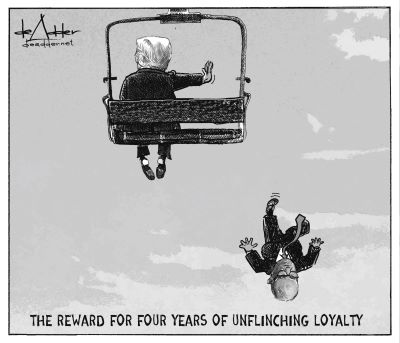Wayback Whensday – A Comics Tutorial
Skip to commentsCapp, Kitchen, and Comix; Hal Foster’s medieval masterpiece; The making of Wednesday Comics, DC’s weekly broadsheet comic book; Charles Dana Gibson educates Mr. Pipp; Flash Gordon and beautiful women.
When Dennis Kitchen tried to get Al Capp to draw an underground comix cover.
It’s hard to name an institution that represents the golden age of underground comix more than Kitchen Sink Press [>coff< Last Gasp, Print Mint, Rip Off Press >coff<], run by publisher Denis Kitchen. Over the years, Kitchen Sink Press has not only been responsible for publishing the best of the underground, but it has also become an advocate of classic comics that have fallen out of public attention, like Will Eisner’s The Spirit as well as Al Capp’s Li’l Abner.
But one thing that most people don’t know is that there was a somewhat lengthy correspondence between Denis Kitchen and Al Capp about getting Capp to do a cover in the same vein [as Will Eisner’s Snarf cover].
From January 1973 to August 1976, Kitchen and Capp held correspondence about this attempted collaboration. This correspondence is now held in the Denis Kitchen collection at Columbia University’s Rare Book and Manuscript Library.

Only later did I realize how I had misplayed the opportunity. I could never have offered Capp enough money to do a cover … I should have said, “Mr. Capp, you doing a cover for an underground comic, your spitting in hippies’ eyes, would be such an unlikely coupling that it will be great publicity for both of us! Imagine the press eating this up.”
**********
The artistry, in both drawing and scripting, of Hal Foster’s Prince Valiant.
However, there was one comic that was unlike any other: Prince Valiant. Its art style was far more like a painting than a doodle, it took place in the days of King Arthur, and it didn’t even use speech bubbles for dialogue… The strip had begun in 1937 as a beautiful,
The strip had begun in 1937 as a beautiful, sprawling epic that took up an entire newspaper page each week with Hal Foster’s trailblazing illustrations. Had I been able to read these, I would undoubtedly have had a different view of this comic.
In recent months, thanks to Fantagraphics’ wonderful work publishing of Foster’s Prince Valiant in oversized book form, I have been able to enter into the world of Foster’s original comics.

While the adventures depicted in the comic are exciting, they would ring hollow if it weren’t for Foster’s attention to the characters undertaking them. Whether original characters like Val and his wife or those Foster ‘inherited’ from other traditions like King Arthur and Merlin, the major figures in the story feel real, and their stories pull readers in.
**********
When DC went broadsheet with Wednesday Comics.
When you look back through comic book history, the most iconic works often have one key characteristic in common, and that’s that they strived to do something different.
A perfect example of this turned ten years old this year … It was Wednesday Comics, a 2009 anthology title at DC Comics. Published in broadsheet, newspaper format to simulate the experience of reading the Sunday funnies of the past, it was a risky move, and one that never became a giant hit or even an awards season giant. But those that did read it recognize it for what it is: one of the most interesting and iconic works of this century, and one that stands tall amongst the legendary efforts its brilliant ringleader edited. This is the story of how a mad idea became something real and magnificent, thanks to the efforts of a particularly driven man and the exceptional creators he recruited.


“Once in a while, if I had a free moment, the bosses would let me come up with a project and edit it, like Batman: Black and White, Solo, (DC: The) New Frontier, Poster Portfolio, and Wednesday Comics,” Chiarello told me, as he listed off what might as well have been a shortlist of the most interesting DC titles of the past two decades. With a track record loaded with award-winning titles that attracted the best and the brightest of the comic industry, you’d think that would have meant he’d have carte blanche to bring these to life. That was…not entirely the case.
Details of Wednesday Comics issues at the Grand Comics Database.
**********
Charles Dana Gibson‘s 1899 graphic novel.
For comic strip devotees, Charles Dana Gibson (1867-1944) is often treated as a sidebar. And yet in the last decade of the 19th and first of the 20th Centuries he may have been the most famous and recognizable cartoonist in America. Best known for his “Gibson Girl” idealizations of middle class feminine youths, he worked mainly in Life and other humor and mass market magazines of the 1890s and 1910s.
Compared to the raucous multi-ethnic action of Mssrs. Dirks, Outcault and Opper, Gibson’s light caricature of parlor room denizens and oh-so-white, oh-so-privileged young lovers may seem tepid. But Gibson was precisely the cartoonist the American bourgeoisie wanted, a master of subtlety and understatement that pricked so gently at the repressions and pomposities of a rising middle class struggling towards propriety.

Gibson’s formidable skills are clearest in his 1899 graphic novel, The Education of Mr. Pipp. The massive 17.25 x 11.75 inch R.H. Russell reprint compiles a monthly series of Life magazine center spreads he had drawn across 1898-99. This American-abroad story has businessman Pipp, his wife and young adult daughters traveling not only thorough Europe but also through every trope of Old World chicanery vs. New World innocence.
The entirety of The Education of Mr. Pipp presented and annotated by Steve Smith/Panels & Prose.
**********
Flash Gordon under the spell of Queen Azura.

Above: Flash “bewitched” by Azura, as mentioned in today’s Flash Gordon.



Comments
Comments are closed.